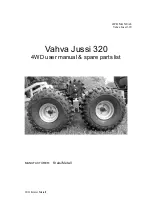
Chapter 2: Intended Use and Monitor Features
Clinician’s Operation Manual
2-1
Intended Use for the WW1020 Oximeter
The BCI
®
WW1020 pulse oximeter is intended for spot-checking applications (non continuous
use). It monitors and displays patient’s functional oxygen saturation
(%SpO
2
), pulse rate
(
p
), pulse signal strength, and pulse amplitude index (PI) readings. It may be used by
physicians, respiratory therapists, nurses, certified nurse assistants, emergency medical
technicians, sleep technicians, and home users. The intended patient population ranges from
neonatal to adult. It may be used on patients with low perfusion or during patient motion. The
WW1020 may be used in the hospital or clinical environment, during emergency land transport,
and in the home.
WARNING! The monitor was not designed or tested to be an apnea monitor.
Intended Use for the WW1000 Oximeter
The BCI
®
WW1000 pulse oximeter is intended to be used for spot-checking (non-continuous use).
It monitors and displays a patient’s functional oxygen saturation (%SpO
2
), pulse rate (
p
), pulse
signal strength, and pulse amplitude index (PI) readings. It may be used by physicians, respiratory
therapists, nurses, certified nurse assistants, emergency medical technicians, sleep technicians,
clinicians, and home users. The intended patient population ranges from infant to adult. It can
be used on patients with low perfusion. The WW1000 may be used in the hospital or clinical
environment, during emergency land transport, and in the home.
WARNING! The monitor was not designed or tested to be an apnea monitor.
Monitor Features
Provides fast, reliable SpO
•
2
, pulse rate, and pulse signal strength measurements on
any patient, from neonate to adult for the WW1020 or from small infant to adult for the
WW1000.
Maintains accurate readings during periods of patient motion (WW1020 only) and when
•
monitoring patients with low perfusion.
Ideally suited for use in hospitals, outpatient clinics, emergency rooms, during emergency
•
land transport, in sleep labs, or in-home use.
Portable and lightweight. Weighs only 330 grams (12 ounces), with 4 “AA” batteries.
•
On-board sensor storage cradle holds the finger sensor when not in use.
•
Power options include four (4) standard “AA” (type IEC LR6) alkaline batteries, a
•
rechargeable Lithium Ion battery pack, USB power, or an AC power adapter.
Rechargeable battery life for a new battery is approximately thirty-one
•
(31) hours for the
WW1020, fifty-four (54) hours for the WW1000.
An easy to read battery gauge indicates the charge level and provides a low battery alert.
•
Large, bright, easy-to-read LED display indicates SpO
•
2
and pulse rate measurements.
2 Nine-segment LED bar graphs indicate pulse signal strength and pulse amplitude index.
•
Optional docking station transforms the device into a table top pulse oximeter, and can
•
also be used to recharge the monitor’s lithium Ion battery pack, and a spare battery pack.
Optional printer allows for printing of trend information or real time data logs.
•
Chapter 2: Intended Use and Monitor Features
Summary of Contents for 10
Page 2: ......
Page 6: ...Table of Contents iv Clinician s Operation Manual This page is intentionally left blank ...
Page 81: ......
















































